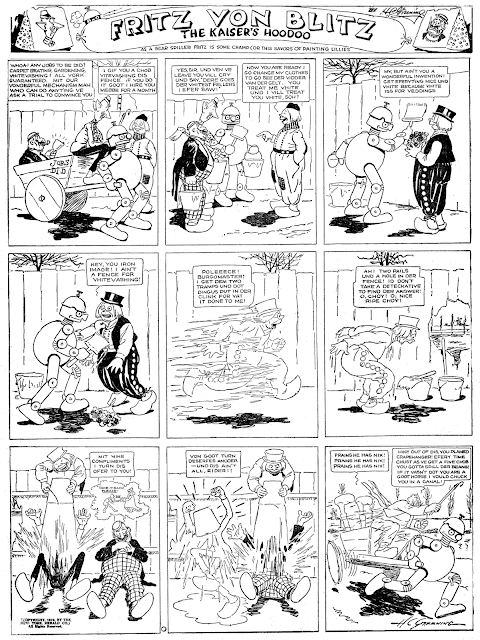Friday, March 31, 2023
Obscurity of the Day Revisited: Fritz Von Blitz, the Kaiser's Hoodoo
Ha ha, der choke ist on me! Dis obscurisch was covered vay back in 2006, when dis blog vas onny der kinder. Cole Johnson dat dodgast scannering damon sent more of der fotos, unt fool dat I am, I fix 'em up fer dot blog. Brains I has nix!
*ahem*
So what can we learn from these samples that we didn't before? Well, you can certainly use them to polish your Pidgin German. Beyond that, the bottom sample is interesting because it came long enough after the end of the war that Greening was trying to rejigger the plot for post-war use. So he just has Fritzi (he's the robot) and his masters running around the countryside looking for odd jobs. Not quite the impact of the really over-the-top wartime strips, so you can see why the series ended.
I hesitate to bring it up, because I'm not sure, and I don't know if it has any deep abiding meaning anyway, but isn't the fellow in the top strip who is trying to sell gunpowder supposed to be a caricatured Jew? You don't see much of that in U.S. newspaper strips (other than Abie the Agent) even in those openly racist days, so it kind of pops out at me. Why did Greening choose that character? As far as I know, German anti-Semitism wasn't really much of an issue in World War I, was it? Is Greening just an anti-Semite looking for an excuse to portray the stereotypical money-grubbing Jew?
Labels: Obscurities
If the figue above is supposed to be a Jewish cariciture, it's an unusual one. the palms-up shrug and that in excitement he says "ooi" might indicate it, but I really don't think it is.
The Jew stereotype is usually drest in black,with the tight crown derby. A Jew would certainly would not have a small, upturned nose, and the frayed, overgrown moustache and beard. Those and the "stink" lines eminating from him are indicative of what Greening and most cartoonists would use for an anarchist. That's probably why he would be dealing in explosive or gunpowder by the barrel.
The third strip above is from early 1919. The Kaiser and Crown Prince have been deposed days before the war ended back in November 1918, and they high-tailed it to the safe haven of Doorn, Holland. Apparently the Herald, or Greening, wanted to keep the psycho robot gags going, and hatin' on Wilhelm too. But the terrible two, shorn of power and a war background, are reduced to standard streetcorner/barnyard comic strip pranks, now with wooden shoes. It's suprising it lasted that long. Think it might be the last WWI themed strip?
I think your initial hunch is the right one. While Hershfield in Abie the Agent, that featured a Jewish protagonist, deliberately avoided the stereotypical markers used to denote Jews, the character, here, in addition to the salesman's bag, while he doesn’t have a hook nose (too derogatory by this time), clearly demonstrates the other markers used to identify Jews: splayed feet and upright hands signifying wild gesticulation. These markers were commonly used in Puck and Judge cartoons in the late 1800s and early 1900s to signify Jews.




